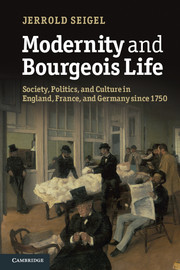 Modernity and Bourgeois Life
Modernity and Bourgeois Life Book contents
- Frontmatter
- Contents
- Illustrations
- Preface
- 1 Introduction: ends and means
- Part I Contours of modernity
- 3 Monarchical centralization, privilege, and conflict: France
- 4 Localism, state-building, and bürgerliche Gesellschaft: Germany
- 5 Modern industry, class, and party politics in nineteenth-century England
- 6 France and bourgeois France: from teleocracy to autonomy
- 7 One special path: modern industry, politics, and bourgeois life in Germany
- Part II Calculations and lifeworlds
- 9 Men and women
- 10 Bourgeois morals: from Victorianism to modern sexuality
- 11 Jews as bourgeois and network people
- Part III A culture of means
- 13 Bourgeois and others
- 14 Bourgeois life and the avant-garde
- 15 Conclusion
- Notes
- Index
14 - Bourgeois life and the avant-garde
Published online by Cambridge University Press: 05 June 2012
- Frontmatter
- Contents
- Illustrations
- Preface
- 1 Introduction: ends and means
- Part I Contours of modernity
- 3 Monarchical centralization, privilege, and conflict: France
- 4 Localism, state-building, and bürgerliche Gesellschaft: Germany
- 5 Modern industry, class, and party politics in nineteenth-century England
- 6 France and bourgeois France: from teleocracy to autonomy
- 7 One special path: modern industry, politics, and bourgeois life in Germany
- Part II Calculations and lifeworlds
- 9 Men and women
- 10 Bourgeois morals: from Victorianism to modern sexuality
- 11 Jews as bourgeois and network people
- Part III A culture of means
- 13 Bourgeois and others
- 14 Bourgeois life and the avant-garde
- 15 Conclusion
- Notes
- Index
Summary
Fluidity, energy, and the promise of transformation
The opposition between cultural innovation and the bourgeoisie has become so ingrained in accounts of modernity and its history that the argument of this chapter may well surprise some readers. It is that beneath all the declarations of mutual hostility between artists and writers on the one hand and bourgeois life on the other, there lay a series of deep and revealing interconnections, and that the substance of these ties provided much of the ground on which the modernist avant-garde would mount its challenges to established forms of life and culture in the years before and just after World War I. The energies on which vanguard movements and figures sought to draw were ones generated by society at large, particularly in the selfsame commercial spheres from which aesthetic rebels sometimes felt most distant, and the pattern by which successive innovations in culture rose up to push aside their predecessors was intricately interwoven with what Joseph Schumpeter called the “creative destruction” that characterized typical bourgeois activities.
Although he did not live to encounter the figures and movements who constituted the avant-garde in the fin-de-siècle, Marx was well aware of these connections. In The Communist Manifesto he and Engels credited the bourgeoisie with revealing that humanity possessed previously unrecognized powers. “The bourgeoisie has been the first to show what man’s activity can bring about. It has accomplished wonders far surpassing Egyptian pyramids, Roman aqueducts, and Gothic cathedrals; it has conducted expeditions that put in the shade all former Exoduses of nations and crusades.” The economy was the sphere in which these forces were rooted, but the impact of their unleashing was felt in every corner of life, most notably in the realm of consciousness and culture. In order to survive and carry on in the world it was creating, the bourgeoisie had constantly to be “revolutionizing the means of production”; these repeated upheavals deprived things as they were of the stability that hitherto veiled the human capacity to alter them, revealing the true nature of social relations and their future.
- Type
- Chapter
- Information
- Modernity and Bourgeois LifeSociety, Politics, and Culture in England, France and Germany since 1750, pp. 482 - 525Publisher: Cambridge University PressPrint publication year: 2012
